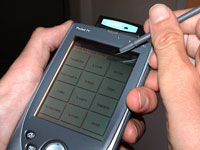Celebrated physicist Stephen Hawking made speech synthesizers famous
a generation ago. But such assistive technologies for people with
disabilities, even today, tend to be expensive, unwieldy, and easily
damaged (requiring down time for repair or replacement). The resulting
inconveniences can dramatically affect the disabled person who counts
on the technology to interface with the outside world in person
or over the Internet.
Now, with funding from Calit2 and a $75,000 grant from the
Blasker-Rose-Miah Fund of the San Diego Foundation, postgraduate
researcher Paul Blair is developing a prototype system to deliver
what he has termed wireless assistive services. The idea is to enable
people with disabilities to enjoy anytime, anywhere access to assistive
technology using commodity wireless devices. The first example of
such a service is a portable, low-cost speech synthesis system that
runs on wireless-enabled, commodity PDAs. Blair has enhanced the
text-to-speech capability by developing a series of custom "buttons"
that can be tapped by the user to quickly form spoken words to convey
common thoughts or basic needs, like ordering in a campus café.
Current capabilities include the ability to type text or tap the
buttons on a PDA, sending the information over a wireless link to
a server, with the resulting synthesized speech played back on the
PDA.
"We are especially excited about this project, because it will
expose many individuals to next-generation assistive technologies.
Not only will UCSD researchers be able to study and develop
wireless, assistive technologies but, through our Calit2
living labs, individuals in the community will have opportunities
to sample the results early on."
- Paul Blair, Calit2" Researcher
|
The application
already runs on the HP iPAQ and the previous generation HP Jornadas,
but work is underway to make the system work on Palm Pilots and
cell phones as well. Also, steps are being taken to interface with
the ActiveCampus Project, which will provide location and contextual
information that can be used to customize the communication buttons
in real-time.
Location information will permit the next assistive service to be
deployed within the Assistive Campus effort: verbally assisted navigation
for blind pedestrians. Blair is investigating the use of enhanced
GPS receivers to permit location determination within half a meter,
enough to permit precise outdoor navigation. Indoors, where GPS
may not be usable, he will use the ActiveCampus system which is
ideal in this environment with its location determination based
on wireless access point signal strengths. Blair is seeking funding
from industry and private foundations to support further development,
including user trials.
Contact: Paul Blair, (858) 822-2058, pblair@ucsd.edu

